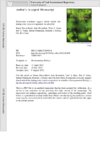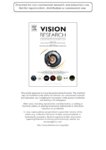1 - 25 of 6
| Creator | Title | Description | Subject | Date | ||
|---|---|---|---|---|---|---|
| 1 |
 |
Digre, Kathleen B.; Couldwell, William T.; Amini, Amin | Photophobia in a blind patient: An alternate visual pathway. Case report. | Photophobia is a common neurological and ophthalmological symptom that has been associated with a growing number of neurosurgical conditions, especially compressive lesions. The exact signaling pathways and neurophysiological features of the disorder are not well understood; however, data from multi... | Photophobia, Blindness, Signaling Pathway, Pretectal Nuclei, Trigeminal Pathway | 2006-12-14 |
| 2 |
 |
Baehr, Wolfgang | Light-dependent redistribution of visual arrestins and transducin subunits in mice with defective phototransduction | PURPOSE: The light-dependent redistribution of phototransduction components in photoreceptor cells plays a role in light adaptation. Upon illumination, rod and cone arrestins (Arr and cArr) translocate from the inner to the outer segments while transducin subunits (Talpha, Tbetagamma) translocate in... | Phototransduction; Protein Kinases; Rhodopsin Kinase | 2003 |
| 3 |
 |
Angelucci, Alessandra | Role for nitric oxide in the development of the ferret retinogeniculate projection | The ferret retinogeniculate projection segregates into eye-specific layers during the first postnatal week and into ON/OFF sublaminae, which receive inputs from either on-center or off-center retinal ganglion cells, during the third and fourth postnatal weeks. The restriction of retinogeniculate axo... | Enzyme Inhibitors; Visual Pathways; Wheat Germ Agglutinin-Horseradish Peroxidase Conjugate | 1996 |
| 4 |
 |
Fuhrmann, Sabine | Extraocular ectoderm triggers dorsal retinal fate during optic vesicle evagination in zebrafish | Dorsal retinal fate is established early in eye development, via expression of spatially restricted dorsal‐specific transcription factors in the optic vesicle; yet the events leading to initiation of dorsal fate are not clear. We hypothesized that induction of dorsal fate would require an extraocu... | 2012-01-01 | |
| 5 |
 |
Frederick, Jeanne M. | The prenyl-binding protein PrBP/δ: A chaperone participating in intracellular trafficking | Expressed ubiquitously, PrBP/d functions as chaperone/co-factor in the transport of a subset of prenylated proteins. PrBP/d features an immunoglobulin-like b-sandwich fold for lipid binding, and interacts with diverse partners. PrBP/d binds both C-terminal C15 and C20 prenyl side chains of phototran... | 2012-01-01 | |
| 6 |
 |
Baehr, Wolfgang; Zhang, Kang | Characterization of human GRK7 as a potential cone opsin kinase | PURPOSE: Homozygous inactivation of the mouse gene for GRK1 (G protein-coupled receptor kinase 1, or rhodopsin kinase) causes severe defects in the recovery of cone phototransduction. However, electroretinographic (ERG) analyses of human oguchi patients with defective GRK1 alleles showed normal or s... | Amino Acid Sequence; Chromosomes, Human, Pair 3; Fluorescent Antibody Technique, Indirect | 2001 |
1 - 25 of 6
